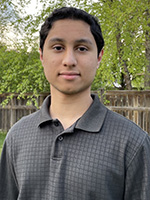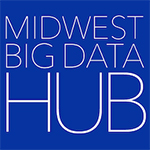By Raleigh Butler
On May 19, 2021, five researchers joined the COVID Information Commons (CIC) “Lightning Talks” webinar hosted by the National Science Foundation-funded Big Data Innovation Hubs. Each speaker was involved in COVID-19 research and gave a brief presentation on their project.

One of the presenters, Minnesota high school student Aditya Kulkarni, was almost indistinguishable from the other researchers in terms of his preparation and professional presentation.
Kulkarni is currently about to go into his senior year. He has been taking college classes since seventh grade. He started off just taking dual-enrollment math courses and now takes all of his classes at the University of Minnesota.
Though he has always been fascinated with programming and data science, the COVID-19 pandemic spurred Kulkarni on to explore data related to that specific issue. He submitted a paper entitled “Human Mobility Patterns Linked to COVID-19 Prone Locations” to the COVID Information Commons (CIC) Student Paper Challenge. His paper won third place, and he was invited to present the research alongside his more senior colleagues on the CIC webinar.
Needless to say, all this is an impressive feat, so I sat down and spoke with him a bit about his interests, school life, and hopes for the future.
How has taking college courses so early in your school career affected you? Do you think you’re more driven or serious than normal?
“Yeah, I think it’s actually been pretty helpful, because . . . I do feel like there’s some differences between taking high school classes and college classes. I mean, high school classes are like, fine—you have your different social groups, but with college, you’re also able to get exposed [to] the cutting-edge research that’s happening, [in] these fields that you’re learning about.”
Do you do dual-enrollment classes where the professors come to your high school, or do you go to the university?
“In this term, the high school isn’t really involved. I’m basically just like a college student traveling to campus coming back later in the evenings. And I’m still in the class with the other college students interacting with them, doing projects.”
Yeah, I was going to ask, if you were socially involved with college students; if you’re more mature than most people your age, then that would be something to appreciate.
“Yeah, and . . . it’s not like people even treat me weird. I just blend in with everyone else, just participating in things.”
Did you take any programming classes? And if so, like, did you enjoy them?
Kulkarni stated that his school offered a small programming course. “It was called Hour of Code. So there was a website, and we would have around an hour a day for one week. And we would just spend [time] seeing how to develop code, mainly block code. But at that time, it was kind of interesting to me seeing how I was able to create things just by dragging and dropping things. And yeah, it was pretty interesting. And [I] think it was mainly animation based . . . just making things move on the screen doing simple tasks. But from there, I think I saw the power and the capabilities that were there with coding.”
Do you and your peers participate in datathons, hackathons, and other kinds of science and computing activities?
This coming term, Kulkarni said, “the high school [won’t be] really involved,” but in the past, he started a STEM-related club at his high school and was very active in terms of connecting fellow students with professionals. Students from the club also team up to participate in hackathons and datathons. Kulkarni says he finds these competitions interesting “especially if there’s a sponsor, I’ll do something related to what they’re doing.”
For the CIC Student Paper Challenge, Kulkarni focused on a data set obtained from SafeGraph.com. This site tracks device movement (no personal information tied in) across the USA. Kulkarni used the available information to create related datasets and compare similar locations in Minnesota. For instance, he found 15 public places with June-July outbreaks and 15 places with no June-July outbreaks. His results show that longer-duration visits to an establishment are associated with COVID outbreaks. He received feedback and mentoring from Midwest Big Data Hub co-PI Shashi Shekhar, a professor of computer science at the University of Minnesota. His final paper is available online in the Columbia University Academic Commons repository.
Are there opportunities for you to build on this specific project that you submitted?
Currently, Kulkarni is pursuing “another direction of economic metrics.” “Even though it’s a human mobility data set, seeing the economic aspect in terms of socioeconomic groups, how [those people] were affected during the pandemic, and then their mobility in terms of that.”
So, I get the feeling you’re wanting to officially pursue computer science and data. If you had to choose a specific subfield to go into, what would you choose?
“I think I would actually go [into] data science. I think that’s the main thing. Then AI, with data sets, just seeing what are the possibilities to explore.” He went on to emphasize how technology could be of use in terms of bettering health situations and other human issues, “there’s just so much [COVID] data going further beyond into the predictive capabilities that can just be done with this much data. Because if there’s a future pandemic, which even though happens pretty rarely, if it happens, then maybe there’s something that we can learn from this one and apply it to the future.”
So, basically, what you like about research is the ability to help and provide insight into what can make the world a better place; is that how you would say it?
“Just because I can, through this mode . . . I can help the community as . . . a broader world or even as a small, small subsection. That’s a way where I can contribute to society, I guess.”
Get involved
Contact the Midwest Big Data Innovation Hub if you’re aware of other people or projects we should profile here, or to participate in any of our community-led activities. The MBDH also has a data science student community, with a monthly webinar. Learn more about the COVID Information Commons webinar series and community.
The Midwest Big Data Innovation Hub is an NSF-funded partnership of the University of Illinois at Urbana-Champaign, Indiana University, Iowa State University, the University of Michigan, the University of Minnesota, and the University of North Dakota, and is focused on developing collaborations in the 12-state Midwest region. Learn more about the national NSF Big Data Hubs community.
